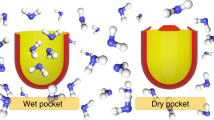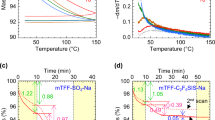Abstract
Hydrophobic hydration is considered to have a key role in biological processes ranging from membrane formation to protein folding and ligand binding1. Historically, hydrophobic hydration shells were thought to resemble solid clathrate hydrates2,3,4, with solutes surrounded by polyhedral cages composed of tetrahedrally hydrogen-bonded water molecules. But more recent experimental5,6,7,8 and theoretical9,10,11,12,13,14,15,16 studies have challenged this view and emphasized the importance of the length scales involved. Here we report combined polarized, isotopic and temperature-dependent Raman scattering measurements with multivariate curve resolution (Raman-MCR)17,18,19 that explore hydrophobic hydration by mapping the vibrational spectroscopic features arising from the hydrophobic hydration shells of linear alcohols ranging from methanol to heptanol. Our data, covering the entire 0–100 °C temperature range, show clear evidence that at low temperatures the hydration shells have a hydrophobically enhanced water structure with greater tetrahedral order and fewer weak hydrogen bonds than the surrounding bulk water. This structure disappears with increasing temperature and is then, for hydrophobic chains longer than ∼1 nm, replaced by a more disordered structure with weaker hydrogen bonds than bulk water. These observations support our current understanding of hydrophobic hydration, including the thermally induced water structural transformation that is suggestive of the hydrophobic crossover predicted to occur at lengths of ∼1 nm (refs 5, 9, 10, 14).
This is a preview of subscription content, access via your institution
Access options
Subscribe to this journal
Receive 51 print issues and online access
$199.00 per year
only $3.90 per issue
Buy this article
- Purchase on Springer Link
- Instant access to full article PDF
Prices may be subject to local taxes which are calculated during checkout



Similar content being viewed by others
References
Ball, P. Water as an active constituent in cell biology. Chem. Rev. 108, 74–108 (2008)
Frank, H. S. & Evans, J. W. Free volume and entropy in condensed systems. 3. Entropy in binary liquid mixtures; partial molar entropy in dilute solutions; structure and thermodynamics of aqueous electrolytes. J. Chem. Phys. 13, 507–532 (1945)
Glew, D. N. Aqueous solubility and gas-hydrates—methane–water system. J. Phys. Chem. 66, 605–609 (1962)
Rossky, P. J. & Zichi, D. A. Molecular librations and solvent orientational correlations in hydrophobic phenomena. Faraday Symp. Chem. Soc. 17, 69–78 (1982)
Li, I. T. S. & Walker, G. C. Signature of hydrophobic hydration in a single polymer. Proc. Natl Acad. Sci. USA 108, 16527–16532 (2011)
Petersen, C., Tielrooij, K. J. & Bakker, H. J. Strong temperature dependence of water reorientation in hydrophobic hydration shells. J. Chem. Phys. 130, 214511 (2009)
Buchanan, P., Aldiwan, N., Soper, A. K., Creek, J. L. & Koh, C. A. Decreased structure on dissolving methane in water. Chem. Phys. Lett. 415, 89–93 (2005)
Zhang, X. Y., Zhu, Y. X. & Granick, S. Hydrophobicity at a Janus interface. Science 295, 663–666 (2002)
Lum, K., Chandler, D. & Weeks, J. D. Hydrophobicity at small and large length scales. J. Phys. Chem. B 103, 4570–4577 (1999)
Chandler, D. Interfaces and the driving force of hydrophobic assembly. Nature 437, 640–647 (2005)
Matysiak, S., Debenedetti, P. G. & Rossky, P. J. Dissecting the energetics of hydrophobic hydration of polypeptides. J. Phys. Chem. B 115, 14859–14865 10.1021/jp2079633. (2011)
Laage, D., Stirnemann, G. & Hynes, J. T. Why water reorientation slows without iceberg formation around hydrophobic solutes. J. Phys. Chem. B 113, 2428–2435 (2009)
Raschke, T. M. & Levitt, M. Nonpolar solutes enhance water structure within hydration shells while reducing interactions between them. Proc. Natl Acad. Sci. USA 102, 6777–6782 (2005)
Garde, S. & Patel, A. J. Unraveling the hydrophobic effect, one molecule at a time. Proc. Natl Acad. Sci. USA 108, 16491–16492 (2011)
Friesen, A. D. & Matyushov, D. V. Non-Gaussian statistics of electrostatic fluctuations of hydration shells. J. Chem. Phys. 135, 104501 (2011)
Cheng, Y. K. & Rossky, P. J. Surface topography dependence of biomolecular hydrophobic hydration. Nature 392, 696–699 (1998)
Perera, P. N. et al. Observation of water dangling OH bonds around dissolved nonpolar groups. Proc. Natl Acad. Sci. USA 106, 12230–12234 (2009)
Perera, P., Wyche, M., Loethen, Y. & Ben-Amotz, D. Solute-induced perturbations of solvent-shell molecules observed using multivariate Raman curve resolution. J. Am. Chem. Soc. 130, 4576–4579 (2008)
Gierszal, K. P. et al. Pi-hydrogen bonding in liquid water. J. Phys. Chem. Lett. 2, 2930–2933 (2011)
Lawton, W. H. & Sylvestre, E. A. Self modeling curve resolution. Technometrics 13, 617–633 (1971)
Tomlinson-Phillips, J. et al. Structure and dynamics of water dangling OH bonds in hydrophobic hydration shells. Comparison of simulation and experiment. J. Phys. Chem. A 115, 6177–6183 10.1021/jp111346s. (2011)
Yang, M. & Skinner, J. L. Signatures of coherent vibrational energy transfer in IR and Raman line shapes for liquid water. Phys. Chem. Chem. Phys. 12, 982–991 (2010)
Torii, H. Time-domain calculations of the polarized Raman spectra, the transient infrared absorption anisotropy, and the extent of delocalization of the OH stretching mode of liquid water. J. Phys. Chem. A 110, 9469–9477 (2006)
Li, F. & Skinner, J. L. Infrared and Raman line shapes for ice ih. II. H2O and D2O. J. Chem. Phys. 133, 244504 (2010)
Liu, C. L., Ye, Y. G., Meng, Q. G., Lu, W. J. & Wang, F. F. In situ Raman spectroscopic observation of micro-processes of methane hydrate formation and dissociation. Spectrosc. Spectr. Anal. 31, 1524–1528 (2011)
Stiopkin, I. V. et al. Hydrogen bonding at the water surface revealed by isotopic dilution spectroscopy. Nature 474, 192–195 10.1038/nature10173. (2011)
Smith, J. D. et al. Unified description of temperature-dependent hydrogen-bond rearrangements in liquid water. Proc. Natl Acad. Sci. USA 102, 14171–14174 (2005)
Gill, S. J., Dec, S. F., Olofsson, G. & Wadso, I. Anomalous heat-capacity of hydrophobic solvation. J. Phys. Chem. 89, 3758–3761 10.1021/j100263a034. (1985)
Garde, S., Hummer, G., Garcia, A. E., Paulaitis, M. E. & Pratt, L. R. Origin of entropy convergence in hydrophobic hydration and protein folding. Phys. Rev. Lett. 77, 4966–4968 10.1103/PhysRevLett.77.4966. (1996)
Ben-Amotz, D. Global thermodynamics of hydrophobic cavitation, dewetting, and hydration. J. Chem. Phys. 123, 184501–184508 (2005)
Acknowledgements
This work was supported by the National Science Foundation (CHE-0847928). We thank B. Widom, D. Chandler, M. Fayer and S. Granick for comments and suggestions; D. Wilcox for writing the SMCR code used in this work; B. Rankin for performing molecular dynamics simulations to determine the number of water molecules in the first hydration shells of n-alcohols (as further described in Supplementary Methods); and D. L. McCaffrey, S. Zukowski and C. DeShaw (undergraduate research students) for assistance in collecting experimental results relevant to this work.
Author information
Authors and Affiliations
Contributions
J.G.D. and K.P.G. performed experimental measurements and reproducibility validations. J.G.D. further contributed to the SMCR data analysis and manuscript writing. P.W. designed and constructed the high-performance Raman system that facilitated these studies. D.B.-A. conceived and supervised the work, and contributed to the data analysis and manuscript preparation.
Corresponding author
Ethics declarations
Competing interests
The authors declare no competing financial interests.
Supplementary information
Supplementary Information
This file contains Supplementary Figures 1-8, a Supplementary Discussion, Supplementary Methods and additional references. (PDF 719 kb)
Rights and permissions
About this article
Cite this article
Davis, J., Gierszal, K., Wang, P. et al. Water structural transformation at molecular hydrophobic interfaces. Nature 491, 582–585 (2012). https://doi.org/10.1038/nature11570
Received:
Accepted:
Published:
Issue Date:
DOI: https://doi.org/10.1038/nature11570
This article is cited by
-
Exploring the Cation Regulation Mechanism for Interfacial Water Involved in the Hydrogen Evolution Reaction by In Situ Raman Spectroscopy
Nano-Micro Letters (2024)
-
Solvent-pair surfactants enabled assembly of clusters and copolymers towards programmed mesoporous metal oxides
Nature Communications (2023)
-
Core-shell nanoparticle enhanced Raman spectroscopy in situ probing the composition and evolution of interfacial species on PtCo surfaces
Nano Research (2023)
-
Macromolecular condensation buffers intracellular water potential
Nature (2023)
-
Isotope effects observed in diluted D2O/H2O mixtures identify HOD-induced low-density structures in D2O but not H2O
Scientific Reports (2022)
Comments
By submitting a comment you agree to abide by our Terms and Community Guidelines. If you find something abusive or that does not comply with our terms or guidelines please flag it as inappropriate.



